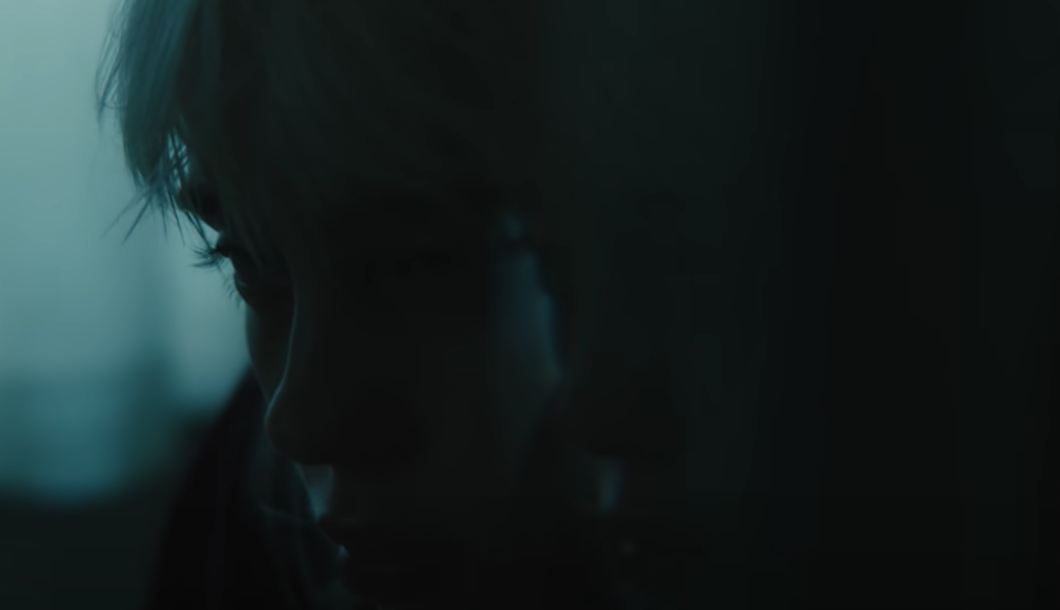Being a synesthesiac, Billie Eilish is all too aware of the importance of color in evoking a feeling. This was the main reason the aesthetic for the Happier Than Ever album photoshoot was awash in beiges “accented” by her shift to a blonde hair tone. The same way two of the lead videos released from the album, “NDA” and “Happier Than Ever,” were strategically saturated in dark blues and blacks. This is, after all, a breakup album in the tradition of many seminal breakup albums, including Back to Black (which, yes, name-checks the color associated with depression). And as such, there are plenty of sentimental and lamenting songs, in addition to those with a tinge more anger in the spirit of SZA’s recent single, “I Hate U.”
Eilish’s message on “Male Fantasy”–her unexpected choice for marking the seventh single release from Happier Than Ever–isn’t quite as tonally drenched in contempt, but she does exhibit the same push and pull between love and hate that can so often come in the wake of a breakup. “Male Fantasy,” which succeeds “Happier Than Ever” as the final track on the record, is, in many respects, both indicative of contempt and amorousness. Encapsulating that sentiment when Eilish croons, “But I loved you then and I love you now/And I don’t know how/Guess it’s hard to know when nobody else comes around/If I’m getting over you/Or just pretending to/Be alright, convince myself I hate you.”
Marking the first time Eilish edited a video entirely on her own (perhaps part of the reason why it’s a simplistic concept), the “narrative” takes place in a similar but different location to the type of apartment featured in “Happier Than Ever.” And rather than bothering to start with any “sunlit moods” or shades of tan, “Male Fantasy” delves right into that blue disposition. In contrast, it takes “Happier Than Ever” until the two minute, twenty-eight second mark to get to that color point, when Eilish opens the door of her apartment to let in a gush of water that changes the entire palette of the video, allowing dark blue and black to saturate everything.
But from the first frame of “Male Fantasy,” we’re meant to apprehend that this is Eilish’s distinctive “depression video” for the album. And, of course, trying to document depression doesn’t usually make for a very interesting storyline, thus all the cliche shots of Eilish sitting or standing aimlessly and listlessly inside her abode, whether staring into the bathroom mirror (complete with an overhead shot that gives one brief flashes to Richie Tenenbaum’s wrist-cutting scene in The Royal Tenenbaums), watching a TV with nothing on it or sitting alone at a table eating (“home alone, tryin’ not to eat). When one is dealing with depression, they’re really just lucky to be able to get out of bed at all. And no, that does not include actually getting out of one’s pajamas.
In fact, there are plenty of scenes of Eilish lazing around in her bedroom, with jump cuts (clearly, as her first time editing on her own, she got a bit buckwild with the technique), indicating elapsed time of her doing pretty much the same thing all day–which is to say, entering the void. Because what else can one really do when they’re both heartbroken and don’t have to meet the conventional job demands of an accursed nine to five? Thus, more constant opening and reopening of the fridge in search of meaning under the guise of food. Then, obviously, there’s the sitting on the kitchen floor in a heap because it’s all too much. There’s also a brief “on the toilette” moment because even the most quotidian of tasks become “eventful” in a depression coma (plus, there was all that eating that requires a girl to make more room in her stomach).
The panning across the living room in the opposite direction as what we saw in “Happier Than Ever” again reminds one that “Male Fantasy” is the “softer” counterpart to the former, which was originally set to close the album before Eilish decided, “Nothing should end on a bad note.” Not exactly as “hardcore” of a sentiment as Eilish’s former self might have come up with. And, speaking of that former self, after going through the heartache, Eilish reconciles she can no longer connect with the person she used to be before “the fall,” describing, “I got a call from a girl I used to know/We were inseparablе years ago/Thought we’d get along, but it wasn’t so.” In short, keeping her own self company in any incarnation–least of all a depressed one–does not have the same effect that it did on Ariana Grande in “thank u, next” when she said, “I met someone else/We’re havin’ better discussions/I know they say I move on too fast/But this one gon’ last/‘Cause her name is Ari/And I’m so good with that.”
A montage of shots briefly synced up to the rhythm of the softly strumming guitar Finneas is playing adds a light sense of the Anxiety that can also become Depression’s good friend. And although the only thing missing is a wrist-slitting moment in the bathtub Eilish is languishing in, she withholds from indulging in that cliche (just as Britney was forced to in the video for “Everytime”), opting instead to conclude the “story” with more soul-searching gazing in the mirror. Alas, anyone who has been through this kind of post-breakup malaise knows that it never really goes away. There’s always some piece of us that remains hollowed out by the demise.





















